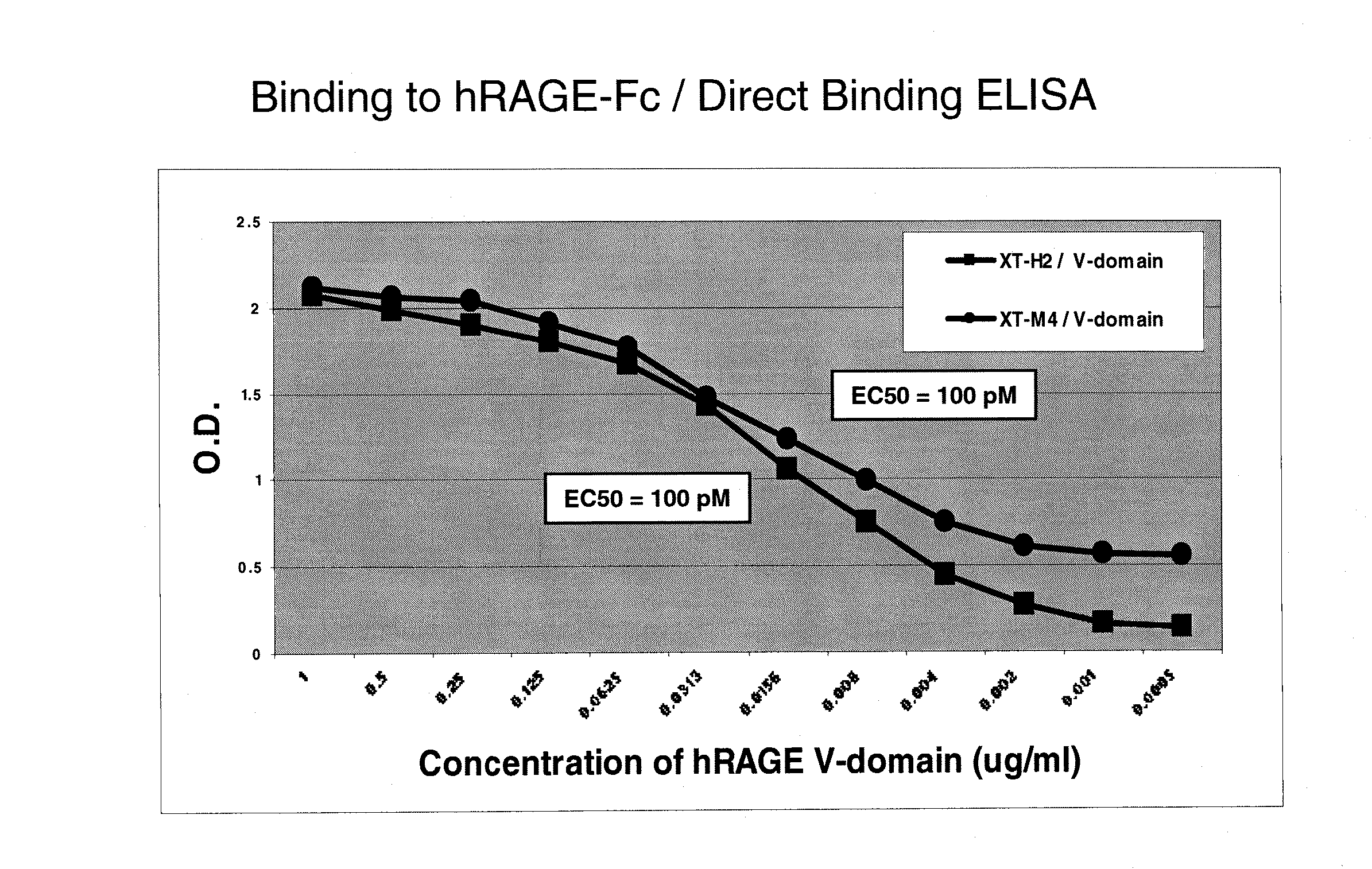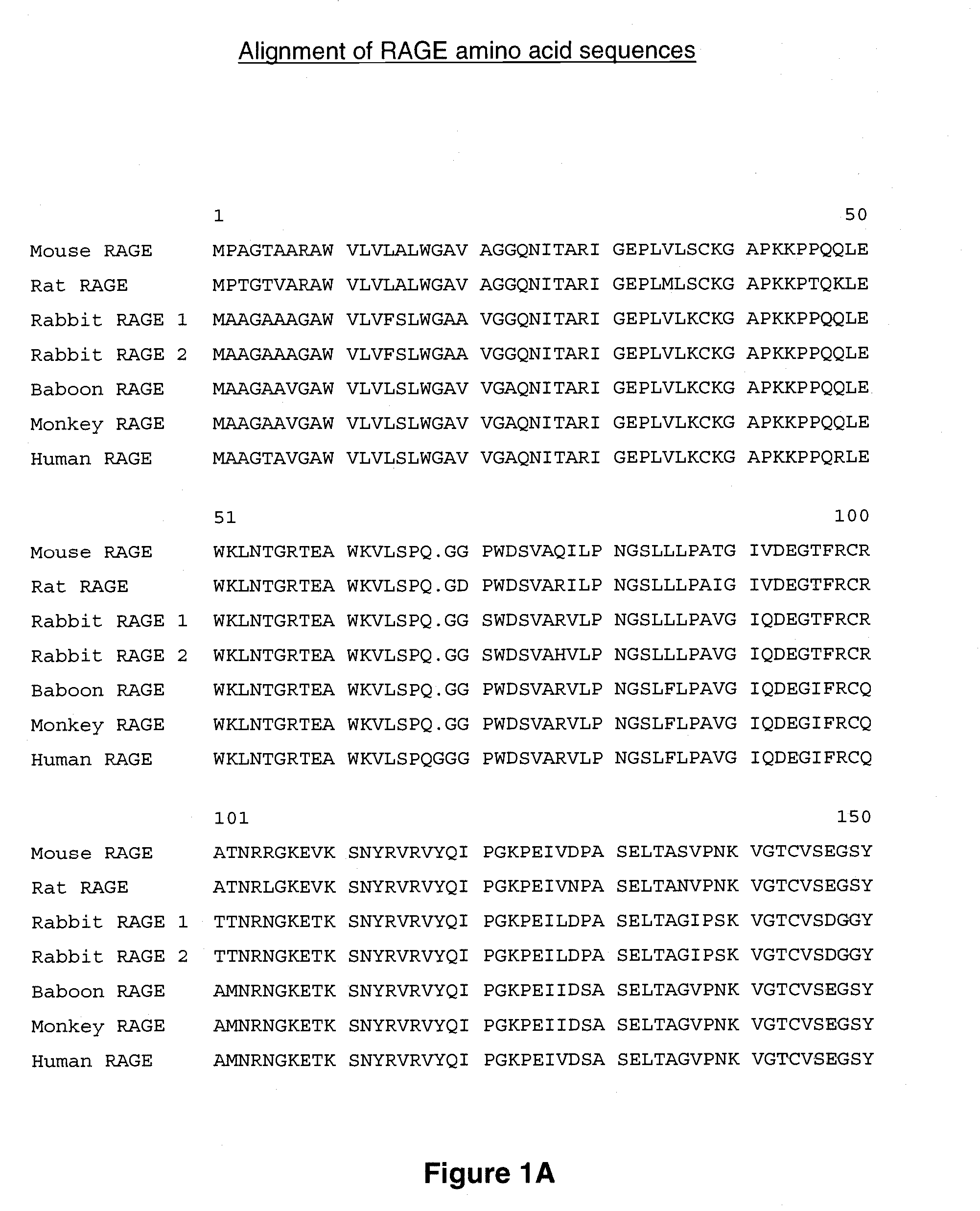Methods and Compositions for Antagonism of RAGE
a technology of antagonism and composition, applied in the field of methods and compositions for antagonism of rage, can solve the problems of unmet medical needs, inability to consistently achieve effective treatment for many of these disorders, time and resource intensive treatment of septic patients
- Summary
- Abstract
- Description
- Claims
- Application Information
AI Technical Summary
Benefits of technology
Problems solved by technology
Method used
Image
Examples
example 1
Preparation of RAGE Constructs
[0293] The amino acid sequences of murine RAGE (mRAGE, Genbank accession no. NP—031451; SEQ ID NO: 3) and human RAGE (hRAGE, Genbank accession no. NP—00127.1; SEQ ID NO: 1) are shown in FIG. 1A-1C. Full length cDNAs encoding mRAGE (accession no. NM—007425.1; SEQ ID NO: 4) and hRAGE (accession no. NM—001136; SEQ ID NO: 2) were inserted into the Adori1-2 expression vector, which comprises a cytomegalovirus (CMV) promoter driving expression of the cDNA sequences, and contains adenovirus elements for virus generation. A human RAGE-Fc fusion protein formed by appending amino acids 1-344 of human RAGE to the Fc domain of human IgG was prepared by expressing a DNA construct encoding the fusion protein in cultured cells using the Adori expression vector. A human RAGE V-region-Fc fusion protein formed by appending amino acids 1-118 of human RAGE to the Fc domain of human IgG was similarly prepared. Human and murine RAGE-strep tag fusion proteins formed by appen...
example 2
Generation of Murine Anti-RAGE Monoclonal Antibodies
[0297] 6-8 week old female BALB / c mice (Charles River, Andover, Mass.) were immunized subcutaneously with the use of a GeneGun device (BioRad, Hercules, Calif.). The pAdori expression vector containing cDNA encoding full-length human RAGE was pre-absorbed onto colloidal gold particles (BioRad, Hercules, Calif.) before subcutaneous administration. Mice were immunized with 3 ug of vector twice per week, for two weeks. Mice were bled one week after the last immunization and antibody titers were evaluated. The mouse with highest RAGE-antibody titer received one additional injection of 10 μg of recombinant human RAGE-strep protein three days before cell fusion.
[0298] Splenocytes were fused with mouse myeloma cells P3X63Ag8.653 (ATCC, Rockville, Md.) at a 4:1 ratio using 50% polyethylene glycol (MW 1500) (Roche Diagnostics Corp, Mannheim, Germany). After fusion, cells were seeded and cultured in 96-well plates at 1×105 cells / well in th...
example 3
Generation of Rat Anti-RAGE Monoclonal Antibodies
[0299] LOU rats (Harlan, Harlan, Mass.) rats were immunized subcutaneously with the use of a GeneGun (BioRad, Hercules, Calif.). The pAdori expression vector containing cDNA encoding full-length murine RAGE was pre-absorbed onto colloidal gold particles (BioRad, Hercules, Calif.) before subcutaneous administration. Rats were immunized with 3 ug of vector once every two weeks for four times. Rats were bled one week after the last immunization and antibody titers were evaluated. The rat with highest RAGE-antibody titer received one additional injection of 10 μg of recombinant murine RAGE-strep protein three days before cell fusion.
[0300] Splenocytes were fused with mouse myeloma cells P3X63Ag8.653 (ATCC, Rockville, Md.) at a 4:1 ratio using 50% polyethylene glycol (MW 1500) (Roche Diagnostics Corp, Mannheim, Germany). After fusion, cells were seeded and cultured in 96-well plates at 1×105 cells / well in the RPMI1640 selection medium, c...
PUM
| Property | Measurement | Unit |
|---|---|---|
| dissociation constant | aaaaa | aaaaa |
| dissociation constant | aaaaa | aaaaa |
| Tm | aaaaa | aaaaa |
Abstract
Description
Claims
Application Information
 Login to View More
Login to View More - R&D
- Intellectual Property
- Life Sciences
- Materials
- Tech Scout
- Unparalleled Data Quality
- Higher Quality Content
- 60% Fewer Hallucinations
Browse by: Latest US Patents, China's latest patents, Technical Efficacy Thesaurus, Application Domain, Technology Topic, Popular Technical Reports.
© 2025 PatSnap. All rights reserved.Legal|Privacy policy|Modern Slavery Act Transparency Statement|Sitemap|About US| Contact US: help@patsnap.com



